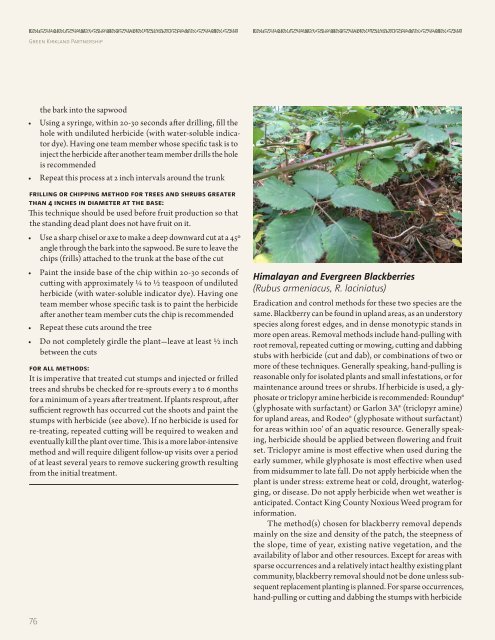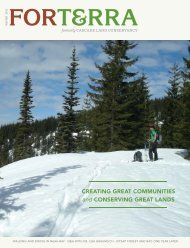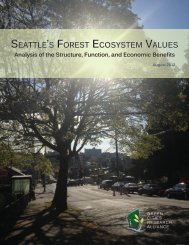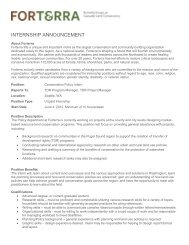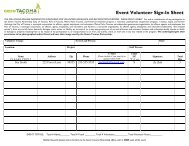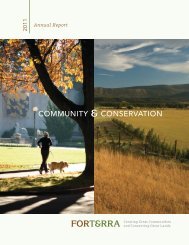Green <strong>Kirkland</strong> Partnershipthe bark into the sapwood• Using a syringe, within <strong>20</strong>-30 seconds after drilling, fill thehole with undiluted herbicide (with water-soluble indicatordye). Having one team member whose specific task is toinject the herbicide after another team member drills the holeis recommended• Repeat this process at 2 inch intervals around the trunkFrilling or chipping method for trees and shrubs greaterthan 4 inches in diameter at the base:This technique should be used before fruit production so thatthe standing dead plant does not have fruit on it.• Use a sharp chisel or axe to make a deep downward cut at a 45ºangle through the bark into the sapwood. Be sure to leave thechips (frills) attached to the trunk at the base <strong>of</strong> the cut• Paint the inside base <strong>of</strong> the chip within <strong>20</strong>-30 seconds <strong>of</strong>cutting with approximately ¼ to ½ teaspoon <strong>of</strong> undilutedherbicide (with water-soluble indicator dye). Having oneteam member whose specific task is to paint the herbicideafter another team member cuts the chip is recommended• Repeat these cuts around the tree• Do not completely girdle the plant—leave at least ½ inchbetween the cutsFor all methods:It is imperative that treated cut stumps and injected or frilledtrees and shrubs be checked for re-sprouts every 2 to 6 monthsfor a minimum <strong>of</strong> 2 <strong>year</strong>s after treatment. If plants resprout, aftersufficient regrowth has occurred cut the shoots and paint thestumps with herbicide (see above). If no herbicide is used forre-treating, repeated cutting will be required to weaken andeventually kill the plant over time. This is a more labor-intensivemethod and will require diligent follow-up visits over a period<strong>of</strong> at least several <strong>year</strong>s to remove suckering growth resultingfrom the initial treatment.Himalayan and Evergreen Blackberries(Rubus armeniacus, R. laciniatus)Eradication and control methods for these two species are thesame. Blackberry can be found in upland areas, as an understoryspecies along forest edges, and in dense monotypic stands inmore open areas. Removal methods include hand-pulling withroot removal, repeated cutting or mowing, cutting and dabbingstubs with herbicide (cut and dab), or combinations <strong>of</strong> two ormore <strong>of</strong> these techniques. Generally speaking, hand-pulling isreasonable only for isolated plants and small infestations, or formaintenance around trees or shrubs. If herbicide is used, a glyphosateor triclopyr amine herbicide is recommended: Roundup®(glyphosate with surfactant) or Garlon 3A® (triclopyr amine)for upland areas, and Rodeo® (glyphosate without surfactant)for areas within 100' <strong>of</strong> an aquatic resource. Generally speaking,herbicide should be applied between flowering and fruitset. Triclopyr amine is most effective when used during theearly summer, while glyphosate is most effective when usedfrom midsummer to late fall. Do not apply herbicide when theplant is under stress: extreme heat or cold, drought, waterlogging,or disease. Do not apply herbicide when wet weather isanticipated. Contact King County Noxious Weed program forinformation.The method(s) chosen for blackberry removal dependsmainly on the size and density <strong>of</strong> the patch, the steepness <strong>of</strong>the slope, time <strong>of</strong> <strong>year</strong>, existing native vegetation, and theavailability <strong>of</strong> labor and other resources. Except for areas withsparse occurrences and a relatively intact healthy existing plantcommunity, blackberry removal should not be done unless subsequentreplacement planting is planned. For sparse occurrences,hand-pulling or cutting and dabbing the stumps with herbicide76
<strong>20</strong>-Year <strong>Forest</strong> <strong>Restoration</strong> <strong>Plan</strong>is recommended. Because blackberry seeds are spread by birds,constant vigilance for new infestations is required.Blackberries in dense patches (thickets) without muchslopeRemoval <strong>of</strong> dense blackberry patches (thickets) may resultin the displacement <strong>of</strong> wildlife that use these areas for coverand forage. Therefore, whenever possible removal work shouldoccur after July 1 st to accommodate wildlife. Depending on theremoval method chosen, this may not always be possible, andmaximum removal effectiveness may take precedence over wildlifeimpacts.• Use appropriately sized mowers or brush mowers to cut theblackberry thicket to the ground several times during themost active growing season (May-September). Repeatedmowing will reduce plant vigor• Either properly dispose <strong>of</strong> the cut canes <strong>of</strong>fsite, chip themwith a chipper, or pile them on top <strong>of</strong> several sheet thickness<strong>of</strong> cardboard, in a dry place for wildlife use—monitor pilesfor re-sprouting• In mid-September, either:Continue to mow until the first hard frostORCut re-sprouts and immediately (within <strong>20</strong>to 30 seconds <strong>of</strong>cutting) dab the stumps with herbicide with water-solubleindicator dye:00 For upland areas use a 50% solution Garlon 3A®, or50% to 100% solution <strong>of</strong> Roundup® (glyphosate withsurfactant)00 For areas within 100' <strong>of</strong> an aquatic resource use a50% to 100% solution <strong>of</strong> Rodeo® (glyphosate withoutsurfactant)00 Having one team member whose specific task is to dabon the herbicide after another team member cuts theblackberry cane is recommended. Use a Weed Wrenchto hand-pull blackberries growing adjacent to wetlands,streams, or other aquatic resourcesORWithout cutting, using a backpack sprayer, spot spray theblackberry re-sprouts with herbicide with water-soluble indicatordye:00 For upland areas use a 2 to 3% solution <strong>of</strong> Garlon 3A® with1% non-ionic surfactant, or a 2% solution <strong>of</strong> Roundup®, ora solution with 2% <strong>of</strong> Roundup® plus 1% (or less) solution<strong>of</strong> Garlon 3A® plus less than 1% non-ionic surfactant00 For areas within 100' <strong>of</strong> an aquatic resource use a 2% solution<strong>of</strong> Rodeo® (glyphosate without surfactant)00 For areas adjacent to wetlands, streams, or other aquaticresources, spot spraying (even with Rodeo®) is not recommended.Hand-pull those blackberries with a WeedWrench• In October, either after the last mowing or after treatment,apply a double layer <strong>of</strong> cardboard sheet mulch covered with4 to 6” <strong>of</strong> arborist mulch• It is imperative that the treated area be monitored for blackberryresprouts for at least 2 <strong>year</strong>s. Either cut and dab thestumps with herbicide (see above) or hand-pull the resproutswith a Weed Wrench• Replant the area with native plants. <strong>Plan</strong>ts can be installedthrough the mulch and cardboard. In many cases, re-planting<strong>of</strong> an area may not be done for 2 to 3 <strong>year</strong>s until control<strong>of</strong> re-sprouting is complete. In other instances, planting inthe late fall immediately after removal work may be desirable.The planting schedule will depend on the area, and must bedetermined at the time <strong>of</strong> project planningScattered individual blackberry plants or relativelysmall blackberry patches within a matrix <strong>of</strong> native vegetationTwo methods are recommended for removing blackberriesgrowing in a matrix <strong>of</strong> healthy native plants: either hand-pullthe blackberries with a Weed Wrench (see below) when thesoil is moist and loose (usually winter through spring), or cutthe blackberry canes and dab the stumps with herbicide in latesummer/early fall. The choice <strong>of</strong> method may depend on thedensity <strong>of</strong> native vegetation, season <strong>of</strong> project, and the availability<strong>of</strong> labor and other resources.Hand-pulling:• When the soil is moist, cut the canes back to approximately12 inches• Either properly dispose <strong>of</strong> the cut canes <strong>of</strong>fsite, chip themwith a chipper, or pile them in a dry place for wildlife use—monitor piles for re-sprouting• Using a Weed Wrench hand-pull the remaining crown andentire root system <strong>of</strong> each plant• It is imperative that the area be monitored for blackberryresprouts for at least 2 <strong>year</strong>s after pulling. If resprouts occur,when the soil is moist, either: use a Weed Wrench to pull theresprouts if they are large enough; or hand-pull the resprouts77


